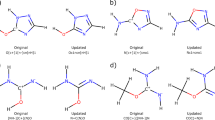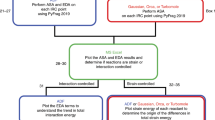Abstract
Chemical understanding is driven by the experimental discovery of new compounds and reactivity, and is supported by theory and computation that provide detailed physical insight. Although theoretical and computational studies have generally focused on specific processes or mechanistic hypotheses, recent methodological and computational advances harken the advent of their principal role in discovery. Here we report the development and application of the ab initio nanoreactor—a highly accelerated first-principles molecular dynamics simulation of chemical reactions that discovers new molecules and mechanisms without preordained reaction coordinates or elementary steps. Using the nanoreactor, we show new pathways for glycine synthesis from primitive compounds proposed to exist on the early Earth, which provide new insight into the classic Urey–Miller experiment. These results highlight the emergence of theoretical and computational chemistry as a tool for discovery, in addition to its traditional role of interpreting experimental findings.
This is a preview of subscription content, access via your institution
Access options
Subscribe to this journal
Receive 12 print issues and online access
$259.00 per year
only $21.58 per issue
Buy this article
- Purchase on Springer Link
- Instant access to full article PDF
Prices may be subject to local taxes which are calculated during checkout



Similar content being viewed by others
Change history
20 November 2014
In the version of this Article originally published, the list of author affiliations was incomplete, and should have appeared as shown below. The list has been corrected in the online versions of the Article. Lee-Ping Wang1,2, Alexey Titov1,2✝, Robert McGibbon2, Fang Liu1,2, Vijay S. Pande2 and Todd J. Martínez1,2,3* 1The PULSE Institute, Stanford University, Stanford, California 94305, USA. 2Department of Chemistry, Stanford University, Stanford, California 94305, USA. 3SLAC National Accelerator Laboratory, Menlo Park, California 94025, USA. ✝Present address: Advanced Micro Devices, Sunnyvale, California 94088, USA. *e-mail: toddjmartinez@gmail.com
References
Ufimtsev, I. S. & Martinez, T. J. Quantum chemistry on graphical processing units. 3. Analytical energy gradients, geometry optimization, and first principles molecular dynamics. J. Chem. Theory Comput. 5, 2619–2628 (2009).
Ufimtsev, I. S., Luehr, N. & Martinez, T. J. Charge transfer and polarization in solvated proteins from ab initio molecular dynamics. J. Phys. Chem. Lett. 2, 1789–1793 (2011).
Luehr, N., Ufimtsev, I. S. & Martinez, T. J. Dynamic precision for electron repulsion integral evaluation on graphical processing units (GPUs). J. Chem. Theory Comput. 7, 949–954 (2011).
Kulik, H. J., Luehr, N., Ufimtsev, I. S. & Martinez, T. J. Ab initio quantum chemistry for protein structures. J. Phys. Chem. B 116, 12501–12509 (2012).
Yin, Y. et al. Formation of hollow nanocrystals through the nanoscale Kirkendall effect. Science 304, 711–714 (2004).
Ensing, B., De Vivo, M., Liu, Z. W., Moore, P. & Klein, M. L. Metadynamics as a tool for exploring free energy landscapes of chemical reactions. Acc. Chem. Res. 39, 73–81 (2006).
Pietrucci, F. & Andreoni, W. Graph theory meets ab initio molecular dynamics: atomic structures and transformations at the nanoscale. Phys. Rev. Lett. 107, 085504 (2011).
Iannuzzi, M., Laio, A. & Parrinello, M. Efficient exploration of reactive potential energy surfaces using Car–Parrinello molecular dynamics. Phys. Rev. Lett. 90, 238302 (2003).
Zimmerman, P. M. Automated discovery of chemically reasonable elementary reaction steps. J. Comput. Chem. 34, 1385–1392 (2013).
Rappoport, D., Galvin, C. J., Zubarev, D. Y. & Aspuru-Guzik, A. Complex chemical reaction networks from heuristics-aided quantum chemistry. J. Chem. Theory Comput. 10, 897–907 (2014).
Virshup, A. M., Contreras-García, J., Wipf, P., Yang, W. & Beratan, D. N. Stochastic voyages into uncharted chemical space produce a representative library of all possible drug-like compounds. J. Am. Chem. Soc. 135, 7296–7303 (2013).
Maeda, S. & Morokuma, K. Toward predicting full catalytic cycle using automatic reaction path search method: a case study on HCo(CO)3-catalyzed hydroformylation. J. Chem. Theory Comput. 8, 380–385 (2012).
Wales, D. J., Miller, M. A. & Walsh, T. R. Archetypal energy landscapes. Nature 394, 758–760 (1998).
Goldman, N., Reed, E. J., Fried, L. E., Kuo, I. F. W. & Maiti, A. Synthesis of glycine-containing complexes in impacts of comets on early Earth. Nature Chem. 2, 949–954 (2010).
Goldman, N. et al. Ab initio simulation of the equation of state and kinetics of shocked water. J. Chem. Phys. 130, 124517 (2009).
Bernasconi, M., Chiarotti, G. L., Focher, P., Parrinello, M. & Tosatti, E. Solid-state polymerization of acetylene under pressure: ab initio simulation. Phys. Rev. Lett. 78, 2008–2011 (1997).
Feller, D. & Peterson, K. A. An examination of intrinsic errors in electronic structure methods using the Environmental Molecular Sciences Laboratory computational results database and the Gaussian-2 set. J. Chem. Phys. 108, 154–176 (1998).
Sousa, S. F., Fernandes, P. A. & Ramos, M. J. General performance of density functionals. J. Phys. Chem. A 111, 10439–10452 (2007).
Harding, M. E. et al. High-accuracy extrapolated ab initio thermochemistry. III. Additional improvements and overview. J. Chem. Phys. 128, 114111 (2008).
Miller, S. L. & Urey, H. C. Organic compound synthesis on the primitive Earth. Science 130, 245–251 (1959).
Trout, C. C. & Badding, J. V. Solid state polymerization of acetylene at high pressure and low temperature. J. Phys. Chem. A 104, 8142–8145 (2000).
Sakashita, M., Yamawaki H. & Aoki, K. FT-IR study of the solid state polymerization of acetylene under pressure. J. Phys. Chem. 100, 9943–9947 (1996).
Virshup, A. M. et al. Photodynamics in complex environments: ab initio multiple spawning quantum mechanical molecular mechanical dynamics. J. Phys. Chem. B 113, 3280–3291 (2009).
Danger, G., Plasson, R. & Pascal R. Pathways for the formation and evolution of peptides in prebiotic environments. Chem. Soc. Rev. 41, 5416–5429 (2012).
Menten, K. M. & Wyrowski, F. in Interstellar Molecules: Their Laboratory and Interstellar Habitat (eds Yamada, K. M. T. & Winnewisser, G.) 27–42 (Springer Tracts in Modern Physics 241, Springer, 2011).
Szori, M. et al. Chemical evolution of biomolecule building blocks. Can thermodynamics explain the accumulation of glycine in the prebiotic ocean? Phys. Chem. Chem. Phys. 13, 7449–7458 (2011).
Wahner, A., Mentel, T. F. & Sohn, M. Gas-phase reaction of N2O5 with water vapor: importance of heterogeneous hydrolysis of N2O5 and surface desorption of HNO3 in a large Teflon chamber. Geophys. Res. Lett. 25, 2169–2172 (1998).
Kasting, J. F. Earth's early atmosphere. Science 1993, 259, 920–926.
Cleaves, H. J., Chalmers, J. H., Lazcano, A., Miller, S. L. & Bada J. L. A reassessment of prebiotic organic synthesis in neutral planetary atmospheres. Origins Life Evol. Biosph. 38, 105–115 (2008).
Isborn, C. M., Luehr, N., Ufimtsev, I. S. & Martinez, T. J. Excited-state electronic structure with configuration interaction singles and Tamm–Dancoff time-dependent density functional theory on graphical processing units. J. Chem. Theory Comput. 7, 1814–1823 (2011).
Titov, A. V., Ufimtsev, I. S., Luehr, N. & Martinez, T. J. Generating efficient quantum chemistry codes for novel architectures. J. Chem. Theory Comput. 9, 213–221 (2013).
Ufimtsev, I. S. & Martinez, T. J. Graphical processing units for quantum chemistry. Comput. Sci. Eng. 10, 26–34 (2008).
Ufimtsev, I. S. & Martinez, T. J. Quantum chemistry on graphical processing units. 1. Strategies for two-electron integral evaluation. J. Chem. Theory Comput. 4, 222–231 (2008).
Ufimtsev, I. S. & Martinez, T. J. Quantum chemistry on graphical processing units. 2. Direct self-consistent-field implementation. J. Chem. Theory Comput. 5, 1004–1015 (2009).
Saunders, V. R. & Hillier, I. H. Level-shifting method for converging closed-shell Hartree–Fock wavefunctions. Int. J. Quantum Chem. 7, 699–705 (1973).
Hu, X. & Yang, W. Accelerating self-consistent field convergence with the augmented Roothaan–Hall energy function. J. Chem. Phys. 132, 054109 (2010).
Pulay, P. Convergence acceleration of iterative sequences—the case of SCF iteration. Chem. Phys. Lett. 73, 393–398 (1980).
Hagberg, A. A., Schult, D. A. & Swart, P. J. in Proceedings of the 7th Python in Science Conference (eds Varoquaux, G., Vaught. T & Millman, J.) 11–15 (SciPy, 2008).
Pedregosa F. et al. Scikit-learn: machine learning in Python. J. Mach. Learn. Res. 12, 2825–2830 (2011).
Becke, A. D. Density-functional thermochemistry. 3. The role of exact exchange. J. Chem. Phys. 98, 5648–5652 (1993).
Guner, V. et al. A standard set of pericyclic reactions of hydrocarbons for the benchmarking of computational methods: the performance of ab initio, density functional, CASSCF, CASPT2, and CBS-QB3 methods for the prediction of activation barriers, reaction energetics, and transition state geometries. J. Phys. Chem. A 107, 11445–11459 (2003).
Swart, M., Sola, M. & Bickelhaupt, F. M. Energy landscapes of nucleophilic substitution reactions: a comparison of density functional theory and coupled cluster methods. J. Comput. Chem. 28, 1551–1560 (2007).
Van Voorhis, T. and Head-Gordon, M. Benchmark variational coupled cluster doubles results. J. Chem. Phys. 113, 8873–8879 (2000).
Zhang, J. and Valeev, E. F. Prediction of reaction barriers and thermochemical properties with explicitly correlated coupled-cluster methods: a basis set assessment. J. Chem. Theory Comput. 8, 3175–3186 (2012).
Peters, B., Heyden, A., Bell, A. T. & Chakraborty, A. A growing string method for determining transition states: comparison to the nudged elastic band and string methods. J. Chem. Phys. 120, 7877–7886 (2004).
Shao, Y. et al. Advances in methods and algorithms in a modern quantum chemistry program package. Phys. Chem. Chem. Phys. 8, 3172–3191 (2006).
Bui, P., Rajan, D., Abdul-Wahid, B., Izaguirre, J. & Thain, D. Work Queue + Python: a framework for scalable scientific ensemble applications. Workshop on Python for High Performance and Scientific Computing (PyHPC, 2011).
Acknowledgements
This work was supported by the National Science Foundation (OCI-1047577), the National Institutes of Health (U54 GM072970) and the Department of Defense through a National Security Science and Engineering Faculty Fellowship from the Office of the Assistant Secretary of Defense for Research and Engineering. This work included calculations performed on the Blue Waters supercomputer at the National Centre for Supercomputing Applications and funded by the National Science Foundation's Office of Cyber Infrastructure. Further computational support was provided by the AMOS program within the Chemical Sciences, Geosciences and Biosciences Division of the Office of Basic Energy Sciences, Office of Science, Department of Energy. We are grateful to E. G. Hohenstein, N. Luehr, S. D. Fried, S. Izmailov, Y. Zhao and C-Y. Wang for helpful suggestions.
Author information
Authors and Affiliations
Contributions
L-P.W., A.T., F.L. and T.J.M. designed the nanoreactor simulation studies. L-P.W., R.M., V.S.P. and T.J.M. designed the energy refinement and network analysis. L.P.W. carried out the simulations and analysis. L-P.W., V.S.P. and T.J.M. co-wrote the manuscript. All authors discussed the results and commented on the manuscript.
Corresponding author
Ethics declarations
Competing interests
The authors declare no competing financial interests.
Supplementary information
Supplementary information
Supplementary information (PDF 1688 kb)
Supplementary information
Supplementary Video 1 (MOV 94703 kb)
Supplementary information
Supplementary Video 2 (MOV 50998 kb)
Rights and permissions
About this article
Cite this article
Wang, LP., Titov, A., McGibbon, R. et al. Discovering chemistry with an ab initio nanoreactor. Nature Chem 6, 1044–1048 (2014). https://doi.org/10.1038/nchem.2099
Received:
Accepted:
Published:
Issue Date:
DOI: https://doi.org/10.1038/nchem.2099



